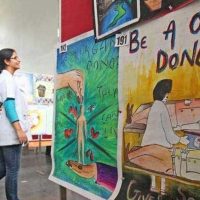Research & Media Projects
Beyond journalism
Gujjarango Aino
Sahapedia
HACE: Research Output
Storytelling Workshops
Gujjarango Aino
Lorem ipsum dolor sit amet, consectetur adipiscing elit. Ut elit tellus, luctus nec ullamcorper mattis, pulvinar dapibus leo.
Sahapedia
Lorem ipsum dolor sit amet, consectetur adipiscing elit. Ut elit tellus, luctus nec ullamcorper mattis, pulvinar dapibus leo.
HACE: Research Output
Tab Content
Storytelling Workshops
Tab Content
Gujjarango Aino
For the last couple years, I have been working with the Van Gujjar Tribal Yuva Sanghathan [VGTYS—a community-led initiative of the Van Gujjars; a forest dwelling semi-nomadic tribe in the Himalayan region] to facilitate an auto-ethnography photo-exhibition project called ‘Gujjarango Aino’; developed by the Van Gujjars of Uttarakhand.
As a journalist, I have always believed in empowering people to tell their own stories and this collaborative work with the community is the main idea behind this archive.
Gujjarango Aaino – Through this live exhibition and photo archive, Uttarakhand’s Van Gujjars invite you into their lives: deep in the forests, upon the hills by the river, into their deras in denizens and on the fields of their resettled colonies. Showcasing snippets of their lives and culture through visuals; they inform, educate, shock and delight as they become in charge of their own narrative. ‘
Gujjarango Aaino’, a Gojri word for ‘the mirror of Van Gujjars’ and showcases the lives of Van Gujjar children, women, men, elders and animals of the community.
Vision and Impact– With most VG households now having smart-phones with cameras as well as some members already using social media to capture their lives and movements; the photo-exhibition and archive project—a collaboration between community leaders and skilled facilitators— seemed like a feasible and accessible project to initiate. Having completed our pilot project with the children of the community; we are currently working with the men and women; hoping to launch the final project early next year.




Sahapedia: East Indian Community of Mumbai
The city of Mumbai has always nurtured the dreams of those who come seeking their fortunes from all across the nation. According to the World Population Review, about 40 percent of the entire population of Mumbai is made up of migrants from the rest of the country. Urbanisation and the ever-increasing numbers of migrants have led to a rapid change in the dynamics of the country’s commercial capital. Its original inhabitant communities such as the Kolis, the Chandraseniya Kayastha Prabhu (CKP) and the Banjaras, are struggling to protect their identities. The East Indians, a unique Catholic community of Mumbai, is one such ‘endangered’ group:
The name, the East Indians, was given by the British to differentiate the community from Goans and Mangaloreans (West Indians) who were also Catholics and had migrated to Mumbai. The area constituting the villages of the East Indian community consists of the former seven islands of Bombay (given to the British as dowry by the Portuguese), the former island of Salsette (ruled by the Portuguese, till the Marathas defeated them, and gifted it to the British), Thana, Bassein (Vasai), Chaul, and parts of Raigad. In 1891, their population was estimated to be about 60,000 across 180 gaothans. Today however, only 3,50,000 East Indians exist in and around Mumbai across 80 gaothans.
As a Research Coordinator for Sahapedia, I created this multi-media research module on Mumbai’s East Indians; documenting their history, culture and social location. The community’s voice and agency is central to the research and has pieces and media in the module that are authored by the community.
Lead Social Scientist HACE: Research Output
As the Social Scientist for the India team of HACE—a UK-based Data start-up analysing cross-sectoral factors affecting child labour to drive change; I led the social research of published, peer-reviewed academic articles detailing topics intersecting with child labour in India: most recently investigating health infrastructure.
I have had the honour to be invited to conduct reportage and storytelling workshops at a few institutes.
At the Indian Institute of Technology (Banaras Hindu University), Varanasi's Film and Media Council, I Spoke about finding stories, ethical reporting and freelancing to an amazing audience.
I have also devised and delivered workshops on slow journalism and ethical reportage at Homegrown and HACE.